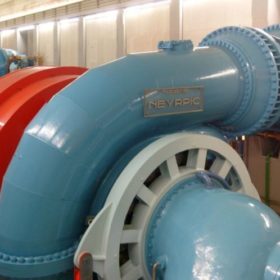As India, the world’s fastest-growing major economy and home to over 1.4 billion people, is investing billions of dollars to ramp up power generation and distribution infrastructure across the country, the demand for reliable, efficient, and smart transformers is also rising at an unprecedented pace.
According to government officials, India’s installed non-fossil fuel capacity stood at 250 GW as of August 2025, over 50% of total installed capacity. Solar power has risen from just 3 GW in 2014 to 123 GW by August 2025, with wind contributing another 52 GW. According to the India Brand Equity Foundation, renewable output grew 24.4 % year-on-year in H1 2025 to reach 134.4 billion kWh, its fastest pace in three years.
At the same time, India’s peak electricity demand crossed 250 GW in May 2024, and total power demand is projected to grow at a 6-6.5 % CAGR through 2030. To meet this surging need, the government aims for 500 GW of renewable capacity by 2030—a transformational leap that will redefine the nation’s transmission and distribution (T&D) backbone.
With renewables’ share in power generation expected to grow significantly, there will also be a push in the demand for next-generation transformers that are capable of handling the intermittent nature of solar, wind, and other non-polluting sources of energy. The grid of the future demands not only more transformers but smarter, adaptive, and sustainable designs that can support India’s ambitious renewable targets and fast-rising power demand.
Why New Generation Transformers
Due to the cyclic and unpredictable nature of renewable energy, the importance of energy storage systems, particularly battery-based solutions, is rising, and to meet these evolving needs, transformer manufacturers have been compelled to rework design and engineering principles with an emphasis on flexibility, resilience, and sustainability.
Because of the rapidly changing power generation landscape, traditional transformers, which are primarily designed for ensuring stability in linear power distribution systems, have to adapt to this new reality of fluctuating loads and variable energy inputs.
Moreover, with India working aggressively to increase its power generation capacity from wind and solar sources to over 500 GW in the next few years, the need for developing and deploying intelligent grid management systems, which requires robust, forward-looking, and innovative transformer designs, has never been more pressing.
The Indian transformer market mirrors this evolution. Valued at USD 3 billion in 2025, it is projected to reach USD 4.47 billion by 2030 (CAGR ≈ 8.33 %). Within this, large-rating power transformers (100 MVA +) are growing even faster at ≈ 9.89 % CAGR, underscoring rising demand for high-capacity, renewable-ready designs.
Reimagining Transformer Engineering
To power India’s sustainable growth story, companies operating in the domain must work in the direction of strengthening transformer design, improving efficiency, and equipping them with advanced systems to ensure a resilient and future-ready grid infrastructure in the country.
Next-generation transformers with advanced systems are set to play a critical role in ensuring grid stability by optimising power flow and managing the intermittent nature of renewable sources. Their deployment will be instrumental in accelerating India’s ongoing energy transformation and building a more resilient power ecosystem.
Additionally, transformers with new features such as enhanced cooling systems and smart thermal management are proving to be very effective in handling load profiles. To meet the growing demand for next-generation grid interface units, companies are also experimenting with advanced materials, such as amorphous metal cores and high-temperature insulation, to improve efficiency and extend the operational life of transformers. One should remember that innovation in materials, insulation, and thermal management is at the core of this transformation.
India’s transmission capacity – now around 1.35 million MVA – will need to more than double to accommodate renewable integration and new industrial corridors. This expansion provides a once-in-a-generation opportunity to embed smarter, greener transformers at the grid’s foundation.
Smart Transformers to Revolutionize Grid Management
The rise of smart transformers equipped with sensors, Internet of Things (IoT) connectivity, and data analytics is going to completely change the way the power grid is managed.
This evolution becomes extremely important in the backdrop of a projected surge in the number of rooftop solar installations across the country, creating a class of consumers who will sell electricity to the grid during the day when output is at peak level and will withdraw during night time when their generation is almost zero.
Another key advantage is that these smart transformers can also monitor grid conditions in real time, adjust voltage levels automatically, and detect faults before they cause system-wide issues.
Moreover, the adoption of smart transformers can help in integrating artificial intelligence into grid management. Using AI can help in predicting grid vulnerabilities by using advanced component usage modelling and early warning systems. This intelligent approach can reduce operations and maintenance (O&M) costs, and it will also increase the efficiency of the existing power grid, paving the way for a more resilient and cost-effective grid infrastructure.
Conclusion
While transformers may not be the first components that come to mind when discussing renewable energy infrastructure, they are important for ensuring that renewable power is efficiently transmitted, balanced, and delivered. Without a resilient, adaptive, and renewable-ready transformer network, India’s energy transition simply can’t happen.
The views and opinions expressed in this article are the author’s own, and do not necessarily reflect those held by pv magazine.
This content is protected by copyright and may not be reused. If you want to cooperate with us and would like to reuse some of our content, please contact: editors@pv-magazine.com.








By submitting this form you agree to pv magazine using your data for the purposes of publishing your comment.
Your personal data will only be disclosed or otherwise transmitted to third parties for the purposes of spam filtering or if this is necessary for technical maintenance of the website. Any other transfer to third parties will not take place unless this is justified on the basis of applicable data protection regulations or if pv magazine is legally obliged to do so.
You may revoke this consent at any time with effect for the future, in which case your personal data will be deleted immediately. Otherwise, your data will be deleted if pv magazine has processed your request or the purpose of data storage is fulfilled.
Further information on data privacy can be found in our Data Protection Policy.